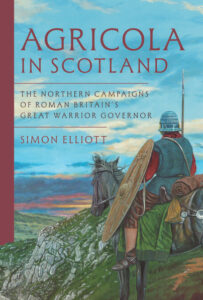Simon Elliott, Agricola in Scotland (Pen & Sword, 2025)
According to Simon Elliott, Gnaeus Julius Agricola was Roman Britain’s greatest warrior governor. Perhaps. It is a bold statement and one that drives Elliott’s analysis in his latest book, Agricola in Scotland. Elliott sets up the imperial context for Agricola’s governorship of Britain, from 77 to 83 CE, while along the way he describes many of the elements behind that fascinating story of conquest.
Elliott begins with some Roman history 101, providing general context for the empire and the provinces, particularly Britain. This includes a glossary of key terms used in the book. After a chapter with an overview of the Republic and Principate Empire, Elliott digs into the Roman military system, again working from the most basic level. This covers the Legions and Auxiliaries, their weapons and armour, and the regional fleets. He moves onto a general description of Roman Britain in the later First Century CE, including its geography, which would prove so important in Agricola’s campaigns. Elliott also surveys the British tribes’ ways of life and their common way of war. An interesting aside here is a discussion of the weather, where Elliott asserts the Roman view that Britain was ‘wet and cold’, a seemingly obvious statement but one that may have had important military ramifications. Elliott discusses the various Roman campaigns from Caesar’s arrival to Boudicca’s rebellion in 60 CE then pauses to outline Agricola’s early life and his rise to prominence. Elliott returns to Boudicca’s rebellion, where we find Agricola serving with Governor Paulinus in north Wales. Paulinus rushed south and defeated Boudicca then left Britain with Agricola, who subsequently served in Asia, Spain, and Rome. Elliott delves into the year of the four emperors, 69 CE, and its favourable impact on Agricola, who picked the winning side and received a promotion to command a legion in Britain.
BUY NOW
The second half of Elliott’s book follows Agricola into Scotland. Elliott notes the expansionist policy of the Flavian emperors set against the psychological impact of the Varian military disaster in 9 CE. Agricola arrived in Britain, which was in turmoil because of mutinous legions. He helped calm the waters and served under two governors before becoming governor himself, with an intervening consulship in Rome. Elliott then describes the role of a Roman governor. Agricola arrived in Britain in 77 CE and immediately went to work reducing Wales and the north of England. Then he marched into Scotland. Elliott surveys the northern lands and the tribes facing Agricola and his army. Elliott stresses the importance of marching camps for following Agricola’s movements. This he proceeds to do over the course of four campaigns leading to the Battle of Mons Graupius. Along the way, Elliott discusses amphibious operations, the aborted invasion of Ireland, and Roman siege-craft. He describes the battle and its aftermath within the contexts of the Romans in Scotland and the emperor Domitian’s rise and fall.
Elliott does well to place Agricola and his campaigns into the broader imperial context, and his introductory material on the legions and Celtic warfare is useful for novice readers in the period, as is his grasp of the naval aspects of the campaigns. Readers familiar with Agricola’s campaigns in Scotland, however, will find very little new information in this book. Indeed, only about one-third of the text directly relates to Agricola in Scotland, and, in the end, Elliott falls back on a well-trodden narrative path for the campaigns and the Battle of Mons Graupius. But that is a story full of cracks that Elliott papers over, which is disappointing, and he spends little time considering alternative sites. Nevertheless, readers new to the Agricolan campaigns will find Elliott’s book a useful gateway into a fascinating, albeit brief, period in the history of Roman Britain.
